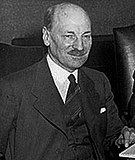1951 UK general election
|
|
|||||||||||||||||||||||||||||||||||||||||||||||||
|---|---|---|---|---|---|---|---|---|---|---|---|---|---|---|---|---|---|---|---|---|---|---|---|---|---|---|---|---|---|---|---|---|---|---|---|---|---|---|---|---|---|---|---|---|---|---|---|---|---|
|
|||||||||||||||||||||||||||||||||||||||||||||||||
|
|
|||||||||||||||||||||||||||||||||||||||||||||||||
|
All 625 seats in the House of Commons 313 seats needed for a majority |
|||||||||||||||||||||||||||||||||||||||||||||||||
| Turnout | 82.6% ( |
||||||||||||||||||||||||||||||||||||||||||||||||
|
|||||||||||||||||||||||||||||||||||||||||||||||||

Colours denote the winning party, as shown in the main table of results. (Map does not show results in Northern Ireland)
|
|||||||||||||||||||||||||||||||||||||||||||||||||
|
|||||||||||||||||||||||||||||||||||||||||||||||||
| 1945 election • MPs |
| 1950 election • MPs |
| 1951 election • MPs |
| 1955 election • MPs |
The 1951 United Kingdom general election was held twenty months after the 1950 general election, which the Labour Party had won with a slim majority of just five seats. The Labour government called the general election for Thursday 25 October 1951 hoping to increase their parliamentary majority. However, despite winning the popular vote, the Labour Party was defeated by the Conservative Party who had won the most seats. This election marked the beginning of the Labour Party's thirteen-year spell in opposition, and the return of Winston Churchill as Prime Minister.
Clement Attlee had decided to call the election after the King's concerns over leaving the country to go on his Commonwealth tour in 1952 with a government that had such a slim majority, that there was danger of a change of government in his absence. (As it transpired the King became too ill to travel and delegated the tour to his daughter Princess Elizabeth shortly before his death in February 1952.)
The Labour government, which by now had implemented most of its 1945 election manifesto, was now beginning to lose many cabinet ministers such as Ernest Bevin and Stafford Cripps due to old age. The Conservatives however, due to the previous year's election, appeared fresher, with more new MPs.
While Labour began to have some policy divisions during the election campaign, the Conservatives ran an efficient campaign that was well-funded and orchestrated. Their manifesto Britain Strong and Free stressed that safeguarding "our traditional way of life" was integral to the Conservative purpose. Significantly, they did not propose to dismantle the welfare state or the National Health Service which the Labour Government had established. As for the Liberals, the poor election results in 1950 only worsened.
...
Wikipedia



